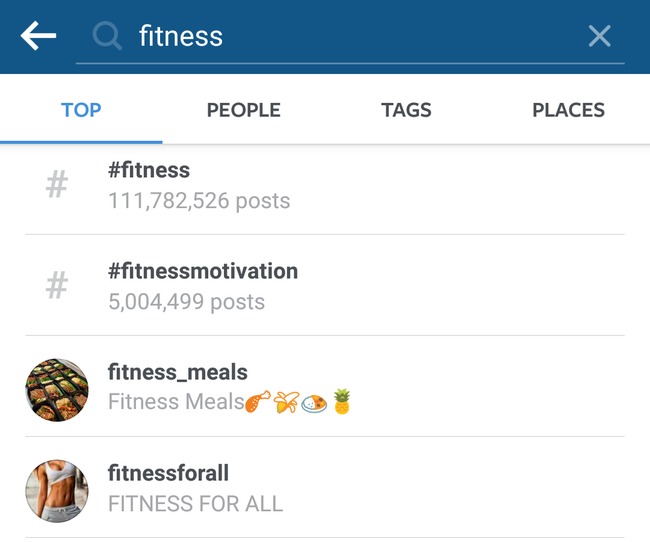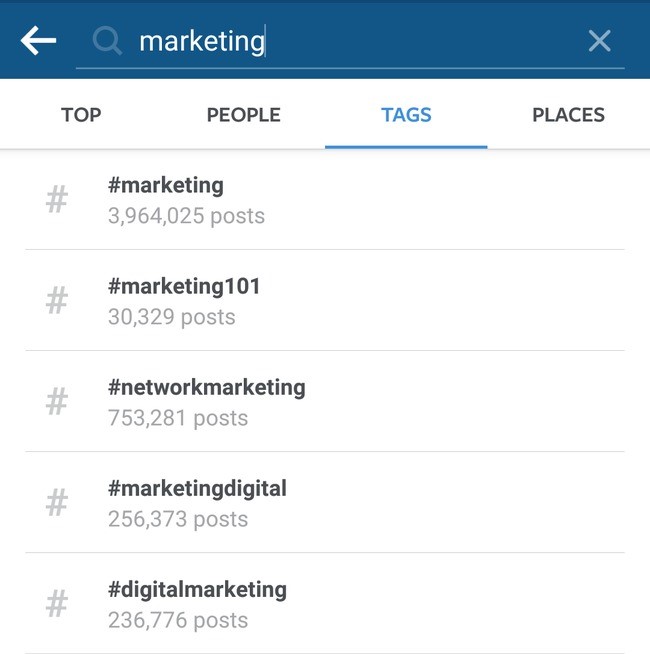
When you post a new picture on Instagram, your followers will see it in their feed. But what about the millions of other users who aren't following you? How can you get your content in front of an audience that you haven't reached yet? The answer is hashtags.
The beauty of hashtags for Instagram is they make your content discoverable and increases your chances of engagement. Aside from getting mentioned by influencers, using hashtags is one of the easiest ways to grow your audience within Instagram. However, it only works if you take the right approach. Here's how to master hashtags for Instagram.
Why You Need to Use Hashtags
The first step to using hashtags to grow your audience is to understand the way they work within Instagram. When you go into the search feature of Instagram and look at what's trending, you'll notice that every topic is a hashtag.

Instagram uses hashtags to categorize content. A great analogy is to think of how you would organize paperwork in an office. You have your papers which go inside folders, and the folders go inside a filing cabinet. In this scenario, the papers are Instagram posts, the folders are hashtags and the filing cabinet is the Instagram platform.
When someone searches #fitness, it's like telling Instagram to search its cabinet for the "fitness" folder and show the latest posts containing that keyword. When you use hashtags in your posts, you're letting Instagram know to put your post in the appropriate folder in case anyone searches for it.
Due to the heavy integration of hashtags, Instagram's search is different than other social networks. Users don't have the ability to search for a plain keyword or phrase such as "fitness." If you wanted to find posts containing the keyword fitness, you'd have to search for #fitness.

What this means for your business is that you need to get into the habit of using hashtags for any main keywords you mention inside of your posts. Using keywords without a hashtag won't make your post discoverable.
Let's dive deeper into how you can use hashtags for Instagram to grow your audience and build your brand.
Use The Correct Number of Hashtags
Since Instagram is less strict about the number of hashtags you can use in your posts than Twitter, it's easy to go overboard. Instagram allows users to post up to 30 hashtags in each post, but it's common practice to keep it between 5-10.
In order to determine what the sweet spot is for your brand, take these two steps:
- Look at how many hashtags influencers in your industry and your competitors use in their posts
- Track the engagement of your posts when you use different amounts of hashtags
When you're starting from scratch, it's a good idea to study what successful people in your industry are doing. If you notice the accounts with the most engagement are using a minimum of five hashtags in most of their posts, that'll give you a clue as to where to start. Then, you'll be able to test out posts with a slightly higher or lower amount to find what works best for you.
Of course, the second half of this is measuring and analyzing your results. You can use Sprout Social's Instagram Analytics to find out which of your posts have the most engagement. Then, look at the amount of hashtags in your highest performing posts to get a concrete idea of how many hashtags you should use.
Use The Right Hashtags
Throwing random hashtags at the end of your Instagram posts isn't going to grow your audience. For instance, using #yourbrandname when people don't know your company won't be too effective. Instead, find out what hashtags are popular within your field and see which ones fit the content your publishing. Your hashtags should be relevant and contain keywords people are actually searching.
There are several different ways to find popular hashtags. Just like with the previous tip, you can begin by researching your competitors and influencers. Pay attention to what hashtags they're using. Jot down the ones that appear the most frequently and see if you can integrate them into your strategy. Just avoid branded hashtags because they likely won't be relevant to your company. For instance, Nike uses a lot of branded hashtags on Instagram, so Adidas and Reebok probably wouldn't want to use the same ones.
Another great option is to track the effectiveness of hashtags you've already used. You can do this using Sprout's Hashtag Performance Report. You'll be able to see which hashtags you use the most, and which ones get the most engagement.

Lastly, you can search Instagram to find hashtags related to your industry. Open up the app and go into the search feature. Make sure the Tags tab is selected.
Then type in a keyword and Instagram will give you some suggestions containing that word, as well as how many posts there are for each suggested hashtag.

Scroll through and pick the hashtags that are most relevant to your industry and the type of content you post. You can write down your top choices in your Instagram marketing strategy so you can reference them when needed.
Once you gather your target hashtags, the next step is to create photos that will be used for the hashtag.
Match Hashtags With the Right Photo
As we mentioned earlier, the hashtags you use should be relevant to the photo you're posting. When you're targeting hashtags that are frequently used, you need to make sure the photo that goes with your Instagram caption will stand out. Remember, even though adding hashtags in your captions can make your posts more discoverable, the image is what will pull people in.
Instagram's search results display in a grid. When a lot of the pictures look similar, they all tend to blend in together. Do a search for your hashtag and pay attention to the photos that show up. Don't just look at the individual pictures, study the grid as a whole. Specifically, you want to look for similarities between the images.

Unlike in our previous tips where our goal is to mimic what others are doing, this time we want to go the opposite direction. In the photo above, we can see that most of the pictures have neutral colors with a lot of brown and tan. If we wanted to post a picture that would stand out in these search results, we'd include more vibrant colors. Since most of the pictures are still/static shots, we might consider doing something with more movement like the race car image. A video could even work, since most of the results are pictures. The goal is to make your post unique.
Now that you know what to do to make your image pop, the next step is to see what the "must-have" elements of your photo should include. For our example, we'd have a groundhog because the hashtag is #groundhogday. It would also be a good idea to have the picture be outdoors, since those seem to get the most engagement for this particular hashtag.
Once you have all of the elements that you want to include, craft your post and share it with the world.
Jump on Trending Topics
Using hashtags that are already trending is a popular way to grow your audience. There are two approaches with this tactic:
- Wait until a hashtag related to your industry is trending
- Use trending hashtags that aren't directly related to your industry
The first approach will give you more targeted results. However, depending on your industry it might be rare that a topic related to it becomes trending.
With the second approach, you're jumping on topics that are already trending but may not have a direct connection with your brand. If you go this route, you'll want to stick with current events like holidays or special events because they're easier to tie back to your company.
For instance, Dolls Kill is an online fashion brand. It doesn't sell flowers, chocolates or other gifts that you might associate with Valentine's Day. But the company manages to use the trending hashtag #Valentines in its posts without forcing it.
No comments:
Post a Comment